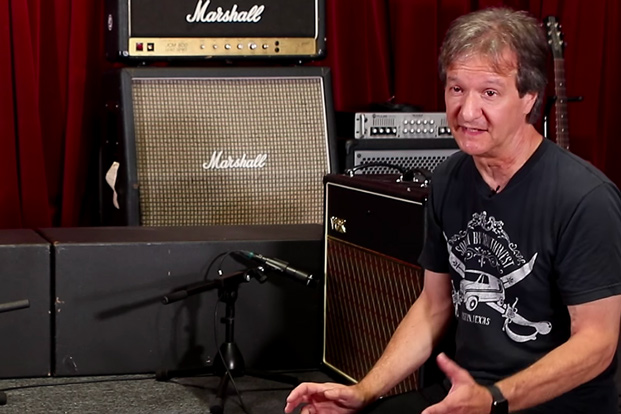Bob Clearmountain's Guide to Recording an Electric Guitar Amp, Part 3

Last time, legendary recording engineer Bob Clearmountain (David Bowie, Bruce Springsteen, the Rolling Stones) showed you how to record an electric guitar amp using two microphones.
In this third part of our series, Clearmountain discusses using two mics—but in a different way.
"I want to talk about a little trick I used to do back in the Eighties," Clearmountain says. "Just because it was in the Eighties doesn’t meant it’s bad. We actually did some pretty cool things back then.
"This is using two microphones. The first microphone is an SM57, just like the way I was talking about before, slightly off-axis in front of the amp.
"Now the second microphone is also an SM57. It could be any other mic you want, but I’ve always done it with an SM57. Now it’s pointing the opposite direction of the amp and there is this hard surface, we use these little…they’re actually speaker stands to create almost like a little chamber here.
"What happens is the sound bounces off of this hard surface. That could be a door…it could be a wall, it could be any kind of hard surface. The sound bounces off it and into that microphone. It’s not a reverb or a delay or an ambience of any kind. It really creates a comb filter effect, and it works mainly on distorted guitars. It wouldn’t sound very good on a clean guitar, probably.
"I’ve never used it on a clean guitar but on a heavy distorted we used to use for Bryan Adams quite a bit back in the Eighties and I think Simple Minds and the Pretenders and some of the things I did back then. You can get this gnarlier kind of a sound… It’s like a very short delay, like a few milliseconds, but it’s not only a short delay, it adds the character of whatever the wood is that you’re using to bounce off the microphone.
"You can alter the sound quite a bit by moving this microphone back and forth. There’s no set distance, you can try different sizes—I mean this is about what we used to use…Was a little longer than this actually—about 8 or 10 feet, something like that. It’s amazing the variety of sounds that you can get just by doing this and you can get a more of an aggressive sound than just one microphone or even two microphones in the front. It’s quite interesting—it’s something you might want to try."
Get The Pick Newsletter
All the latest guitar news, interviews, lessons, reviews, deals and more, direct to your inbox!
Since 1980, Guitar World has been the ultimate resource for guitarists. Whether you want to learn the techniques employed by your guitar heroes, read about their latest projects or simply need to know which guitar is the right one to buy, Guitar World is the place to look.











